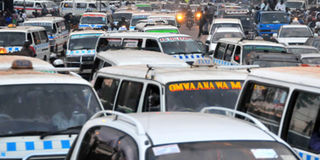Prime
Flyover won’t decongest Kampala city

Motorists leave Kampala city through Entebbe Road. This is one of the areas with the heaviest jams in Kampala. The proposed flyover project will also benefit this place. Photo by Abubaker Lubowa
What you need to know:
The government could explore other options such as developing other towns into cities so as to reduce the population in the capital.
Kampala- On April 11, 2014, NTV Uganda, the sister television station of this newspaper, ran a story in its weekend edition news broadcast in which the director Transport Planning of Uganda National Road Authority made a revelation that the government needs [$150m or about Shs375 billion] to construct flyovers in Kampala as a move to decongest the city.
Kampala, the capital city of Uganda, is also the country’s central business area. It is currently experiencing a large influx of people moving in from different parts of the country in search of a good living – ‘Ugandan dream’.
Thus the value attached to Kampala has led to a drastic increase in the number of people coming into the city. To some extent, this has also attracted more street children and more pressure on the already existing slums.
Every morning from 6:30am to 10am, all roads leading to Kampala city are filled with traffic jam. Motor vehicles, motor cycles (the commonly known as boda-bodas) and pedestrians are all seen trying to access the city centre.
The same situation occurs in the evening from 5:30pm to 9:00pm as people retire to their homes after a busy day. In both cases, the situation worsens after a heavy downpour.
Last week, the Sunday Monitor in an article titled, Why government can afford a train transport system for Kampala, indicated that a survey done in Kampala early this year by Iganga Foundation titled Smart Moving Kampala, said 24,000 hours are lost each day by commuters due to traffic jams. It pointed specifically at areas near the Old Taxi Park where many streets are blocked by taxis (matatus) waiting to enter the park. This happens daily and the flow of traffic is impossible in the nearby streets.
Earlier reports indicate that Kampala was planned for only 500,000 people and that was soon after independence. At that time, Kampala city was designed as a business centre with a few public offices. Entebbe town was the administrative city, and Jinja town the industrial city. But currently, almost all government ministries and other public offices are located in Kampala and also a number of industries are cropping up. So what do you expect, congestion or decongestion?
So the question is: Will the construction of flyovers put to rest the problem of congestion in Kampala city? The answer to that will come with time. This is where efficient planning is required.
Big questions
Below are some of the questions the city planners should ask themselves to efficiently plan for the city: What brings many people to Kampala? Where do they come from? And lastly why are other cities not congested? The answers to these questions will definitely change their way of reasoning that flyovers will reduce congestion in Kampala. As a matter of fact, if the above questions are not comprehensively answered, the flyovers will instead increase congestion.
The 2013/2014 Uganda budget was estimated to be Shs12 trillion. This means that the flyover project is a representative of 62.5 per cent of the financial year soon coming to an end. Yet all this money is proposed to be spent on only a small portion of the country. This also questions the economic feasibility of the project.
To this, I argue that people continuously flood Kampala city for only one aspect of life - improved livelihood. This is in terms of assured income, proper health care, quality education and other goods and services. This continuous influx is what I call “the socio-economic internal migration of Uganda” with Kampala city being the centre of ‘gravity’.
A good example for this desire for Ugandans to be within and/or around Kampala is the PLE, UCE and UACE exams which were released recently. These results revealed that schools in Kampala district and those within 20 km radius, performed better than others combined.
On the healthcare side, it can be estimated that morbidity and mortality rates are more in areas 20km in radius away from Kampala city. Health facilities in these areas are always experiencing problems of drug stock-outs, inadequate health personnel and many more others.
Economically, these areas are retarded. What raises eyebrows most is that traders on Busia-Jinja highways travel all the way to Kampala to purchase different products. Yet these products get to Kampala city via that same route. A paradox, it must be said.
Way forward
So what is the way forward? Let the government invest that money to improve service delivery in areas vulnerable to internal migration. Currently, the best strategic sectors for investment in Uganda are energy and agriculture. Uganda has the potential of becoming the energy and food hub of Africa. Development of these sectors can create enormous job opportunities right from production, distribution, marketing and not forgetting the education and health sectors. The rampant influx of people, boda bodas and commuter taxis in Kampala city will be history. Improvement of city transport is equally important; but better planning is required.
What still baffles is whether the colonial psyche is still affecting our minds to the extent of thinking that Kampala is the only city with development potentials of Uganda? A better city is where city residents can work, grow, live and be secure - these form the attributes of a better city.
So why can’t government construct new cities in areas such as Lwela and Nakasongola? These are redundant areas yet they connect to many other towns in the country. Another option could be developing the existing towns. This will reduce pressure on Kampala.
The author is a development consultant at
Innovative Health Solutions




